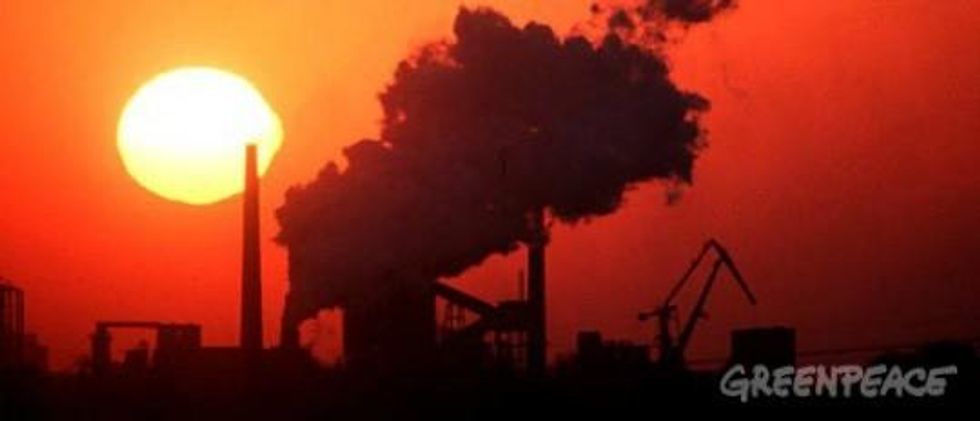Carbon Capture 'Scheme' Linked to Large Quakes: Report
New study reveals dangers of fossil fuel industry-backed climate change mitigation strategy

The new research will likely bolster critics of CCS who have long argued that such engineering schemes present "significant risks" while perpetuating the burning of fossil fuels.
The study, Gas Injection may have Triggered Earthquakes in the Cogdell Oil Field, Texas, found a correlation in timing between a series of "magnitudes 3 and larger" quakes occurring between 2006 and 2011 and the injection of significant volumes of CO2 during that time, marking the first time that carbon storage has been linked to tremors of such severity.
These findings suggest the "significant risks [that] accompany large-scale carbon capture and storage as a strategy for managing climate change," write report authors and seismologists Wei Gan of China University of Geosciences and Cliff Frohlich of the University of Texas-Austin.
Touted as a solution to the growing threat of carbon dioxide emissions, CCS--sometimes called carbon sequestration--pumps the industrial waste of operations like coal-fired power plants back underground in the name of mitigation. Environmental groups, however--including Greenpeace and Friends of the Earth--have long warned that CCS technology is a costly and ineffective "scheme" promoted by the coal industry and does nothing to effectively combat global warming.
The research initially sought to link the earthquakes to the practice of "waterflooding," which is frequently employed to enhance crude oil production by injecting large amounts of water underground to move oil deposits into wells.
According to AFP, reporting on the study:
There were 18 earthquakes of magnitude 3 or higher from 2006-2012, including a 4.4 earthquake on September 11, 2011.
Of 93 quakes in the Cogdell area from March 2009 to December 2010, three during that time period were greater than magnitude 3.
Water injection could not have explained these quakes, which came after a period of 24 years in which no earthquakes were detected, the researchers said.
_____________________
An Urgent Message From Our Co-Founder
Dear Common Dreams reader, The U.S. is on a fast track to authoritarianism like nothing I've ever seen. Meanwhile, corporate news outlets are utterly capitulating to Trump, twisting their coverage to avoid drawing his ire while lining up to stuff cash in his pockets. That's why I believe that Common Dreams is doing the best and most consequential reporting that we've ever done. Our small but mighty team is a progressive reporting powerhouse, covering the news every day that the corporate media never will. Our mission has always been simple: To inform. To inspire. And to ignite change for the common good. Now here's the key piece that I want all our readers to understand: None of this would be possible without your financial support. That's not just some fundraising cliche. It's the absolute and literal truth. We don't accept corporate advertising and never will. We don't have a paywall because we don't think people should be blocked from critical news based on their ability to pay. Everything we do is funded by the donations of readers like you. Will you donate now to help power the nonprofit, independent reporting of Common Dreams? Thank you for being a vital member of our community. Together, we can keep independent journalism alive when it’s needed most. - Craig Brown, Co-founder |

The new research will likely bolster critics of CCS who have long argued that such engineering schemes present "significant risks" while perpetuating the burning of fossil fuels.
The study, Gas Injection may have Triggered Earthquakes in the Cogdell Oil Field, Texas, found a correlation in timing between a series of "magnitudes 3 and larger" quakes occurring between 2006 and 2011 and the injection of significant volumes of CO2 during that time, marking the first time that carbon storage has been linked to tremors of such severity.
These findings suggest the "significant risks [that] accompany large-scale carbon capture and storage as a strategy for managing climate change," write report authors and seismologists Wei Gan of China University of Geosciences and Cliff Frohlich of the University of Texas-Austin.
Touted as a solution to the growing threat of carbon dioxide emissions, CCS--sometimes called carbon sequestration--pumps the industrial waste of operations like coal-fired power plants back underground in the name of mitigation. Environmental groups, however--including Greenpeace and Friends of the Earth--have long warned that CCS technology is a costly and ineffective "scheme" promoted by the coal industry and does nothing to effectively combat global warming.
The research initially sought to link the earthquakes to the practice of "waterflooding," which is frequently employed to enhance crude oil production by injecting large amounts of water underground to move oil deposits into wells.
According to AFP, reporting on the study:
There were 18 earthquakes of magnitude 3 or higher from 2006-2012, including a 4.4 earthquake on September 11, 2011.
Of 93 quakes in the Cogdell area from March 2009 to December 2010, three during that time period were greater than magnitude 3.
Water injection could not have explained these quakes, which came after a period of 24 years in which no earthquakes were detected, the researchers said.
_____________________

The new research will likely bolster critics of CCS who have long argued that such engineering schemes present "significant risks" while perpetuating the burning of fossil fuels.
The study, Gas Injection may have Triggered Earthquakes in the Cogdell Oil Field, Texas, found a correlation in timing between a series of "magnitudes 3 and larger" quakes occurring between 2006 and 2011 and the injection of significant volumes of CO2 during that time, marking the first time that carbon storage has been linked to tremors of such severity.
These findings suggest the "significant risks [that] accompany large-scale carbon capture and storage as a strategy for managing climate change," write report authors and seismologists Wei Gan of China University of Geosciences and Cliff Frohlich of the University of Texas-Austin.
Touted as a solution to the growing threat of carbon dioxide emissions, CCS--sometimes called carbon sequestration--pumps the industrial waste of operations like coal-fired power plants back underground in the name of mitigation. Environmental groups, however--including Greenpeace and Friends of the Earth--have long warned that CCS technology is a costly and ineffective "scheme" promoted by the coal industry and does nothing to effectively combat global warming.
The research initially sought to link the earthquakes to the practice of "waterflooding," which is frequently employed to enhance crude oil production by injecting large amounts of water underground to move oil deposits into wells.
According to AFP, reporting on the study:
There were 18 earthquakes of magnitude 3 or higher from 2006-2012, including a 4.4 earthquake on September 11, 2011.
Of 93 quakes in the Cogdell area from March 2009 to December 2010, three during that time period were greater than magnitude 3.
Water injection could not have explained these quakes, which came after a period of 24 years in which no earthquakes were detected, the researchers said.
_____________________

